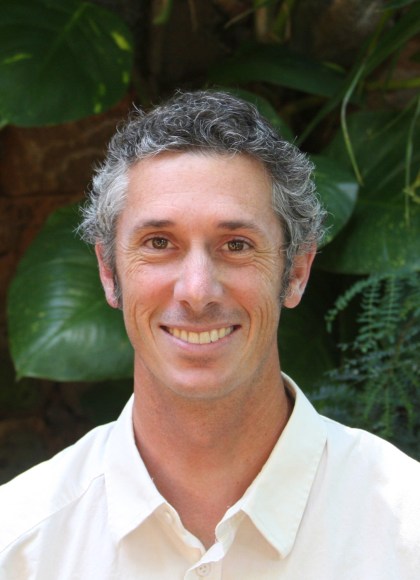Self-Guided Easy Hikes in Hawai‘i Volcanoes National Park
If you find yourself only having one day to venture through Hawai‘i Volcanoes National Park, there are several short hikes that will offer you a glimpse of what it’s like to live next to an active volcano.
Volcano Art Center’s Niaulani Campus Trail
Just outside the park in Volcano Village is a four-acre rare old-growth tropical rainforest growing in volcanic ash from the 18th century. Some of the trees at the Volcano Art Center (19-4074 Old Volcano Rd., Volcano, 808/967-8222) are at least 200 years old and more than 65 feet tall. The Niaulani Campus Trail, which is filled with placards explaining the area and art, is only a 0.7-mile-long loop and is flat. Bird lovers will delight in this opportunity to see native birds. The tour is easy to complete on your own, but a one-hour guided tour is available every Monday (including holidays) at 9:30am (free). Stop by for an hour-long yoga class on Wednesdays at 5:30pm to unwind after a day of hiking.
Crater Rim Trail
Although a large part of Crater Rim Drive is currently closed due to the sulphur dioxide (vog) from Halema‘uma‘u, it is possible to hike along the Crater Rim Trail. If you park at the Thomas A. Jaggar Museum and hike along the Crater Rim toward the visitors center, you will be offered unparalleled views of the vast Kilauea Caldera. Along the way you pass through desert-like conditions with sparse vegetation to lush native tropical forests. You will also encounter the Steam Vents, where the water heated from the volcanic heat rises up from cracks in the earth. The hike along the Crater Rim Trail to/from the Thomas A. Jaggar Museum to the visitors center is approximately 2.5 miles and can take anywhere from 45 minutes to an hour. Parts of it are shaded while other parts are in an open field. The trailhead for this Crater Rim hike is left of the museum and parking lot and also across the street from the visitors center (next to Volcano House). Parts of the trail have been paved and provide a good place for road or mountain biking.
Newsletter Signup
By clicking ‘Sign Up,’ I acknowledge that I have read and agree to Hachette Book Group’s Privacy Policy and Terms of Use
Sulphur Banks Trail
From the visitors center parking lot you can get a good glimpse of some interesting volcanic geology. The Sulphur Banks Trail is a short and easy hike that offers intriguing sights. Bright yellow mineral deposits of sulphur line the trail as volcanic gases spew from the earth. This trail may remind some people of the volcanic vents in Yellowstone, and it just reminds one of the geologic variety found here on the Big Island. Interpretive signs offer explanations of the volcanic activities so it’s easy to understand what you’re seeing. To get to this trail, walk to the left of the visitors center past the Volcano Art Center. A paved trail will lead you through a grassy field with a heiau (temple) and down a hill. If you see signs warning you that you may encounter volcanic gases, you’re going the right way. It’s 0.5 mile one way from the visitors center to the Sulphur Banks. If you want to make it into a longer hike, you can cross the road and connect to the Crater Rim trail by the Steam Vents and hike all the way to the Thomas A. Jaggar Museum.
Earthquake Trail
If from the visitors center you head left (behind the Volcano House facing the caldera) on Crater Rim Trail, you’ll walk one mile roundtrip toward Waldron Ledge on the Earthquake Trail, so named due to the damage this area received during the 1983 6.6 magnitude earthquake. Waldron Ledge is known to be one of the best views in the park, and the trail, which is paved and wheelchair- and stroller-accessible as well as bike-friendly, presents an easy walk.
Devastation Trail
Farther up Crater Rim Drive, most visitors hike along the one-mile roundtrip Devastation Trail, which could aptly be renamed Regeneration Trail. The mile it covers is fascinating; it’s one of the most-photographed areas in the park. It leads across a field devastated by a tremendous eruption from Kilauea Iki. The area was once an ‘ohi‘a forest that was denuded of limbs and leaves, then choked by black pumice and ash. The vegetation has regenerated since then, and the recuperative power of the flora is part of an ongoing study. Notice that many of the trees have sprouted aerial roots trailing down from the branches: This is total adaptation to the situation, as these roots don’t normally appear. As you move farther along the trail, tufts of grass and bushes peek out of the pumice and then the surroundings become totally barren.
From the Pacific to the Atlantic, through prairies and bayous to snow-capped mountains, uncover the best of the US with Moon USA State by State.
Newsletter Signup
By clicking ‘Sign Up,’ I acknowledge that I have read and agree to Hachette Book Group’s Privacy Policy and Terms of Use


